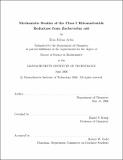Mechanistic studies of the Class I ribonucleotide reductase from Escherichia coli
Author(s)
Artin, Erin Jelena
DownloadFull printable version (8.794Mb)
Other Contributors
Massachusetts Institute of Technology. Dept. of Chemistry.
Advisor
Daniel S. Kemp.
Terms of use
Metadata
Show full item recordAbstract
Ribonucleotide reductases (RNRs) catalyze the conversion of nucleotides to deoxynucleotides, providing the monomeric precursors required for DNA replication and repair. The class I RNRs are found in many bacteria, DNA viruses, and all eukaryotes including humans, and are composed of two homodimeric subunits: R1 and R2. RNR from Escherichia coli (E. coli ) serves as the prototype of this class. R1 has the active site where nucleotide reduction occurs, and R2 contains the diferric-tyrosyl radical (Y · ) cofactor essential for radical initiation on R1. The rate-determining step in E. coli RNR has recently been shown to be a physical step prior to generation of the putative thiyl radical (S · ) on C439. Thus, the chemistry of nucleotide reduction is kinetically invisible, which has precluded detection of intermediates in the reduction process with the normal substrate. Perturbation of the system using mechanism-based inhibitors and site-directed mutants of R1 and R2 has provided the bulk of the insight into the reduction mechanism by inference. (cont.) The work described in this thesis makes use of two mechanism-based inhibitors, 20 - azido - 20 - deoxyuridine - 50 - diphosphate (N3UDP) and 20 - deoxy - 20,20 - difluorocytidine - 50 - diphosphate (dFdCDP), and one active site mutant, E441Q R1, to further our understanding of the catalytic capabilities of RNR. The results provide strong support for a 30 - ketodeoxynucleotide intermediate postulated to lie on the normal reduction pathway, as well as for the elimination of nitrogenous base in the active site of R1 during inhibition. The studies further show that under physiologically relevant reducing conditions, inhibition of RNR by the clinically important nucleotide analog dFdCDP is a result of covalent modification. An essential part of these studies was the development of a robust, high-yielding enzymatic method for the selective 50 - phosphorylation of cytidine, 20 - deoxycytidine, 20 - deoxyuridine and their analogs that are not amenable to standard chemical phosphorylation methods.
Description
Thesis (Sc. D.)--Massachusetts Institute of Technology, Dept. of Chemistry, 2006. This electronic version was submitted by the student author. The certified thesis is available in the Institute Archives and Special Collections. Vita. Includes bibliographical references.
Date issued
2006Department
Massachusetts Institute of Technology. Department of ChemistryPublisher
Massachusetts Institute of Technology
Keywords
Chemistry.